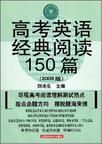高考英语经典阅读150篇
出版时间:1970-1 出版社:上海科学技术出版社 作者:刘决生 编 页数:152
前言
2008年高考,全国各地有19份高考英语试题各展风采。与教育部考试中心命制的几份全国卷相比,单独命题的地区和省份,如上海、北京、天津、重庆、湖北、湖南、山东、江西、安徽、福建、浙江、辽宁、广东、四川、陕西、海南、宁夏等,或者直接按照教育部考试中心的说明要求命题,或者是以其为指导,结合当地英语教学实际制订了相应的考试说明,并据此命制反映当地特色的英语试题。综观全国各地高考英语试题,我们不难发现,高考英语阅读理解的比例正在加大。自2005年6月高考开始,上海市、浙江省高考英语试题均增设了属于阅读理解泛读范围内的六选五阅读新题型,至此,全国19份高考英语试题的阅读理解篇幅均为五篇以上,浙江省更是多达六篇阅读,并占了50分的比重(占总分150分的1/3)。由此可见,高考阅读理解能力的提升,对于高考英语学科获得高分极为关键。因此,熟悉高考英语命题特点,进行系统训练,从而快速有效地提升英语阅读理解答题能力至关重要。参加本书编写的老师既有华东师范大学外语学院毕业的从事高考英语测试专业研究的英语教育硕士,又有多年奋战在高三教学一线的名师。本书编者深入研究,参照了教育部考试中心对近年高考英语阅读理解命题的权威分析,针对高考命题的方式并结合真题分析,撰写了详细的高考英语阅读理解应试指导文章,力图简明扼要地系统阐述高考英语阅读理解的命题特点,同时结合各地最新试题进行具体分析,为广大高中学生备战高考提供详细的答题策略指导。与众多模拟试题不同的是,本书精选了最近三年全国各地高考英语阅读理解真题150篇(其中2008年各地高考真题96篇),按照试题的选材范围分为人物经历篇、科技说明篇、话题谈论篇、现象介绍篇、广告信息篇、植物动物篇、异域风情篇、趣闻轶事篇和阅读新题型等九大板块。阅读训练部分之所以全部采用各地高考真题,是因为真题的典型陛更强、命题方式更权威、导向更明确。全国各地高中各年级的学生都可以根据自己的实际情况选用。我们编写此书的初衷就是要给广大考生提供最新、最经典的高考阅读理解试题,让考生在最短的时间内取得阅读理解的最高分。令人欣慰的是,本书推出三版以来,深受广大师生的普遍欢迎,多次重印即是对本书的充分肯定。为了满足广大高三新生备战2009年高考的需要,我们在保留原来编写体例的基础上,根据2008年全国各地的最新高考英语试题,彻底重编了此书,以全新的内容奉献给读者。王影、李珊珊、刘莉、张鹏、孙欣、程晓蔷、李艳、姚红、乔志、刘思源、张晓晓、陈翔等同志参与了本书的编写。作为《中学英语经典试题150系列》丛书中的一本,上海科学技术出版社英语编辑室的编辑们为这本书的出版付出了辛勤的劳动,在此致谢。由于编写时间有限,书中不足之处在所难免,还望读者不吝指正。
内容概要
《高考英语经典阅读150篇》(2009版)系统阐述高考英语阅读理解的命题特点和答题策略精选近年全国各地高考英语阅读典型真题,又按选材范围分为人物经历篇、科技说明篇、话题谈论篇、现象介绍篇、广告信息篇、植物动物篇、异域风情篇、趣闻轶事篇和阅读新题型等九大板块。
书籍目录
前言第一章高考英语阅读理解命题特点与答题指导第二章高考英语阅读理解经典真题150篇第一节人物经历篇第二节趣闻轶事篇第三节科技说明篇第四节现象介绍篇第五节异域风情篇第六节植物动物篇第七节广告信息篇第八节话题谈论篇第九节阅读新题型参考答案
章节摘录
Passage 10 (陕西卷) Runners in a relay (接力) race pass a stick in one direction. However, merchants passed silk, gold, fruit, and glass along the Silk Road in more than one direction. They earned their living by traveling the famous Silk Road. The Silk Road was not a simple trading network. It passed through thousands of citied and towns. It started from eastern China, across Central Asia and the Middle East, and ended in the Mediterranean Sea. It was used from about 200 B. C. to about A. D. 1300, when sea travel offered new routes (路线). It was sometimes called the worlds longest highway. However, the Silk Road was made up of many routes, not one smooth path. They passed through what are now 18 countries. The routes crossed mountains and deserts and had many dangers of hot sun, deep snow and even battles. Only experienced traders could return safe. The Silk Road got its name from its most prized product. Silk could be used like money to pay taxes or buy goods. But the traders carded more than just silk. Gold, silver, and glass from Europe were much found in the Middle East and Asia. Horses traded from other areas changed farming practices in China. Indian merchants traded salt and other valuable goods. Chinese merchants traded paper, which produced an immediate effect on the West. Apples traveled from central Asia to Rome. The Chinese had learned to graft (嫁接) different trees together to make new kinds of fruit. They passed this science on to others, including the Romans. The Romans used grafting to grow the apple. Trading along the Silk Road led to world-wide business 2,000 years before the World Wide Web.The people along the Silk Road did not share just goods. They also shared their beliefs. The Silk Road provided pathways for learning, diplomacy (外交), and religion (宗教).1. Its probable that traders along the Silk Road needed_____. A. to remember the entire trade routeB. to know the making of productsC. to receive certain special trainingD. to deal with a lot of difficulties2. The Silk Road became less important because ______. A. it was made up of different routesB. silk trading became less popular C. sea travel provided easier routesD. people needed fewer foreign goods3. New technologies could travel along the Silk Road because people _____. A. learned from one anotherB. shared each others beliefs C. traded goods along the routeD. earned their living by traveling4. What is the best title for the passage? A. The Silk Road: Past and Present. B. The Silk Road: East Meets West C. The Silk Road: Routes Full of Dangers. D. The Silk Road: Pathways for Learning
图书封面
评论、评分、阅读与下载
用户评论 (总计1条)
- Justsoso!没有什么特色。
相关图书
- 用证据说话
- 用证据说话
- 用证据说话
- 数据库基础与Visual FoxPro9.0程序设计
- 电磁兼容原理与技术
- 计算机网络技术及应用实例
- 新编基础会计
- 网络营销理论与实践
- 会计信息系统
- Access 2000基础与应用题解及实验指导
- 地质信息技术基础
- 信息网络技术实践教程
- ASP.NET网络编程技术与实践
- 现代化学基础
- 完全实战演练
- Access 2007课程设计案例精编
- 计算机应用基础
- Pro/ENGINEEER Wildfire 4.0机械设计实例教程
- 大型互联电网运行可靠性基础研究
- 1+1数据库混合开发技术丛书·ASP.NET 2.0+SQL Server 2005数据库开发与实例
- Visual Basic 2005+SQL Server 2005数据库开发与实例
- 移动通信
- Pro/ENGINEEER Wildfire 4.0注塑产品造型设计
- MATLAB工程计算
- Delphi课程设计案例精编
